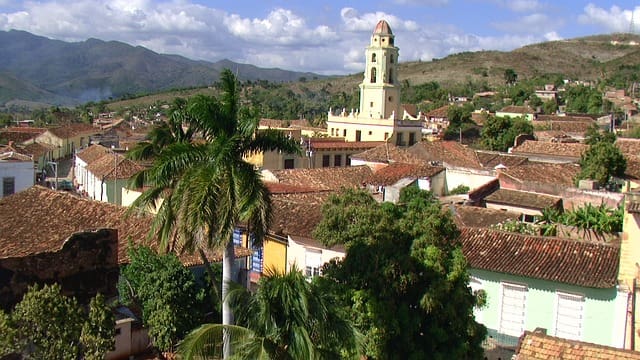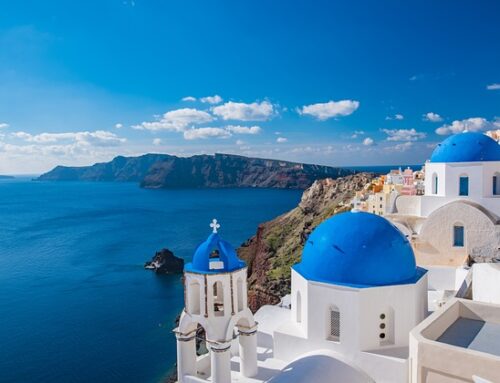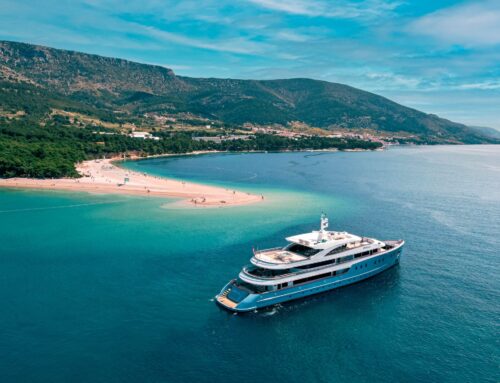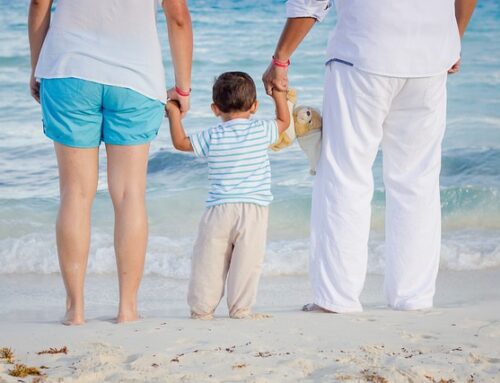An Honest Guide For Cuba – How To Plan A Great Trip

Uncovering Cuba’s Many Gems, A Complete Guide To Planning Your Trip
As the sun rays dance on white caps on pristine beaches, the turquoise water coruscates like a basket full of diamonds. The verdant hills and rainforests dotted with wildlife and waterfalls, monstrous mountain ranges, and cities full of vim and vigor are wrapped in a communist fabric. The Cuban island is an exceptional and nonpareil destination that resides on the top of the bucket list of many!

While the rest of the world continued to make headway and transformed with time, the 1959’s socialist revolution and the ensuing US trade embargo shackled Cuba in time. Because its charm and beauty lie in its antiquity, this is the reason Cuba is revered the most. People want to visit it before the magic wand of time and tourism transforms it. The vintage American Cadillacs still roar through the infectious music streets, and the horses and carts rattle between the pastel-hued decaying mansions. Cuba is an island that differs completely from the island lying on its periphery.

Havana is the Capital of Cuba and proves to be a rather potent mix of dereliction and licentiousness. The city well preserves its history in the shape of colonial buildings that blend beautifully with the tumbledown tenements of the Cubans. The Havana’s unfaltering love for salsa, the uncurbed dancing, and the overwhelming cocktails are electrifying and a stark contrast to the shaky surroundings. The galvanizing city is per se an unparalleled urban experience.

Other cities in Cuba are equally enthralling. Santiago de Cuba is an epitome of Afro-Caribbean culture uniting pastel covered buildings with grand cathedrals. Trinidad, a relic of cobblestone streets, melting away colonial façade, a heavenly precinct. As charming as these cities are, for the majority of the tourists the sandy beaches are the greatest attraction. The fanciful beaches with the warm turquoise waters are extremely beautiful. Others scour inland, fishing about the verdant, limestone peaks of Vinales. The vivacious town is interspersed with brightly colored colonial-era wooden houses. It is in this valley that the world famous tobacco of Cuba is cultivated.

Cuba is slowly unfolding its magical pathway to the Western world. The fascinating island is a media frenzy. Travelling to Cuba independently to dig deeper is challenging, though it’s worth it. It stands as the most captivating places to visit and truly lives up to its name. The resilient country is slowly marching its way to normality. The struggling yet welcoming lively natives will greet you warmly. The iconic antique cars and tacky buildings maybe a kitsch that take you back in time, but they also remind you of the unstable growth of the country.
Unravelling The Mystery
There is much more to the vibrant island that you do not discover unless you are there. There is always more than what you hear. And, it is for this reason that we will now probe into its multi-layered landscapes and regions so you will get to see a more explicit picture that is both endearing and poignant.
Starting on an honest note, traveling to Cuba shatters many hearts. It is not at all easy.
Brush Your Map Reading Skills
Cuba is an expanse of 110,000 square kilometers, comprising of 15 provinces. Traveling from one end to the other is a journey of 1,100 kilometers. What may seem like an easy destination on a map is actually an excruciating trip of many hours.

Make a rough plan of the initial stops you will make but do not count on it. The clock ticks at a snail’s pace in Cuba. Buses are rarely on time, and it might take days before you get your bus tickets. The map will help you find alternative routes, the next nearest city, or a nearby bus or shared taxi stop.
A lot of planning won’t help much as there is not one definite route to travel to Cuba. A map by Autentica Cuba will be more helpful in acquiring all the details as compared to any other maps you will find online. The Cuba Lonely Planet guidebook is also helpful for jotting down important points which you can later refer to. In Cuba, you never know when you have to rearrange and plan things from the beginning.
Cuban Money Tips

Cuba has two currencies, it is a tricky and painful issue. One currency is for the natives, and the other one is for the tourists. It’s a labyrinth you wouldn’t want to get stuck into. All you need is the tourist currency. The American debit and credit cards are not accepted. You must not forget to stash in enough money for your trip that you can get exchanged to the Cuban Tourist currency (CUC) in Cuba. The queues at the airport are excruciatingly long. You can get your money exchanged anywhere, but you will have to wait for same interminable period.
Hold your breath, the problems do not end here. Along with the 3% currency exchange fee, Cuba also charges a 10% penalty when exchanging USD dollars to Cuban Tourist currency.
A golden tip: Get your money exchanged to Euros first and then to CUC. To save the 13% difference it’s something worth doing.
- The Cuban Convertible Peso (CUC) – 1:1 exchange rate with the US Dollar.
The first thing on your list as soon as you step off the plane. You will find it only inside the country at the airport or any of the banks across the country.
- The Cuban Non-Convertible Peso (CUP)
It is also known as Meneda Nacional (MN) or the National Peso – 24 CUPS to one CUC exchange rate.
Since the two currencies have very subtle differences, look at the wordings very closely. Be wary whenever you get back a CUC bill. Getting CUP notes and coins is a run-of-the-mill scam, given the destabilized situation in the country. Being aware of the exchange rates is important as you may need to convert in order to pay for something.
Using Cuban National Pesos
As tourists you are not allowed to use the CUP, spending our own currency will charge you inflated prices. In the past, only government owned the local businesses. Although the locals have been granted the right, they are under strict surveillance. Nevertheless, dabbling in local currency is not difficult nor illegal. Only that it will be hard to get an exchange from CUC to CUP, but many people are up for it since CUC hold more worth to them.
How Much Will It Cost To Visit Cuba?
Cuba is a socialist country, yet stratospheric prices are imposed across the entire country, making Cuba significantly expensive.
Given the conditions prevailing in Cuba, it is ironic that Cuba is not a cheap destination. Visitors are set up for the resort packages, but over the years a prolific pricing system has inflated prices. The local restaurants will proffer a special tourist menu. To your disbelief, it will be limited in options with inflated prices. All this signals that you’re being ripped off, especially in places where CUC and CUP pricing is not clear. In these conditions, it won’t be surprising to discover a black market that firmly functions for the locals who pay CUC prices for luxury goods.
You can find ATM’s everywhere but individual ATM fees apply, so it is best to carry cash with you.
Predicting Expenses
Residence
For a single room in a Casa Particulare per night, you will be charged 25-40 CUC that is $25-$40. The breakfast and meals will charge you extra 5 CUC and 10 CUC. Tourist hotels will be considerably more.
Food

Prices fall between 20 cents for a local Peso Pizza to 15 CUC for a three-course meal in a local restaurant.
Beverages and Alcohol
You can get cheap alcohol and beers in some bars, they will cost you around 5 CUC. One litre bottle of mineral water will cost you less than 1 CUC.
The Entrance Fees
The contrast in prices for tourist entrance fees and the local fee for entrance to museums and historical sites will be clearly visible. The difference is about 20 times the price locals’ pay. Sometimes. AGAIN sometimes, in the face of luck, they might let you go away with it praising your efforts for bearing up with the inflation at government-run establishments. And then there are those who simple give you a clear veritable NO.
Extra Costs in Cuba
Buses: The bus fare will fall between 11-25 CUC one way
Taxi: For a round trip it will cost 40-60 CUC
Colectivos: It depends on the distance, but you must inquire from the locals. Although, prices range from 10-20 CUC.
The Local Buses: The local buses that you will find in beach towns near the coast will cost you 2 CUC.
Internet Cards: A card lasting for an hour will cost you 2 CUC, and a five-hour card will amount to 10 CUC.
Airport Departure Tax: Cache 25 CUC for the time when you will leave. You will have to pay this to the officials as you will be stamped out of the country.
Checking On Visa Requirements
Whichever airline you take, you should ask about the inclusion of a Visa with your ticket. Make sure you get the right Visa for your tour. There are different types of Visas for different categories of travelers. You need to have a tourist card before you set to travel. The validity of your passport should be beyond the duration of your stay. There is strict health screening at the entry ports in case you do not carry with you any infectious disease. If by chance you hit into someone carrying a disease, you are prone to a 10 days medical observation.

How Can Americans Travel To Cuba
Americans can have access to Cuba through proper licensed channels. For many years Americans have traveled Cuba in organized tour groups that have a special license and a written permission letter. Many fly through a non-US Gateway, such as Canada or Mexico. To circumvent the US authorities, the Visa card purchased at the airport is stamped instead of the passport or no passport stamp is given at all.
However, many significant changes have taken place for travelers from the US.
New Rules for People Travelling To Cuba From America
December 2014 witnessed a change in the relations between Cuba and the United States. Diplomatic relations with Cuba were restored which put an end to the trade embargos imposed since 1960.
The US Department of treasury issued amendments to the sanctions that granted Americans a ‘general license’ if they fall under one of the 12 categories of travel listed. The 12 categories comprise of family visits, professional research, educational and religious activities, journalistic activities, the public live performances and humanitarian projects, and any projects that support the Cuban people. Meeting the requirements of any of the 12 categories will free you from the need to apply for a license for traveling to Cuba. Many of the travelers state their reason of visit at the Passport control.
The US Department of Transportation announced on 31st August that only 20 daily non-stop flight would operate from the US to Havana. 14 of the flights were to take off from Florida. The operators include American, Alaska, JetBlue, Delta, Southwest, Frontier, Spirit, and United.
The changes also allow the use of U.S. credit and debit cards in Cuba but for your own safety carry cash.
Having a Travel Insurance for Cuba Is Binding
In early 2010 it became imperative for all the foreign visitors to own a travel insurance policy by The Cuban government. The policy will cover the full duration of the trip before they set their foot in the country. Medical assistance in Cuba is quite expensive and this Travel Insurance policy i s required.
Abode in Cuba
The ‘Casa Particular’ is a homestay, which is the best and most comfortable option in smaller towns. The local transform their homes into guesthouses, where you can occupy a room. Sometimes you get to own a separate bathroom too. Otherwise, you share it with the family. The charm lies in living among the locals and gaining first-hand experience of the Cuban life. You will have Cubans to guide you in case you need help.

You need not to get frightened if you are asked to handover your passport at each of the Casa Particular. The owners are required to apply for a special government license in order to run this business. They have to register each visitor and show their daily income. Everything remains transparent between the locals and the government. Nevertheless, all the money goes in the hands of the locals and they make sure you are looked after. You are charged separately for the meals you take. You can find your way to Casas of other cities on CubaJunky or on the recommendations of the Casa owners who will call up their contacts in other cities, who are often the relatives, they will be there waiting to pick you up in the next city.
Hostels
There aren’t many options for hostel set-ups in Cuba, but there are some larger Casas that have multiple rooms and dorm in them.
Lower Your Expectations For Food in Cuba
If you are a foodie, you are very likely to be heart-broken. But we cannot forget the fact that Cuba is a country still reeling, the citizens survive on meager rations. There won’t be much that even the supermarkets could offer you.
Some of the Dishes You Can Try
There are some of the Cuban dishes that you can try to shake up your taste buds. ‘Ropa Vieja’ (shredded beef) is served with rice and fried plantains, fresh lobster on the coastal fringes and ‘Arroz con Pollo,’ and the simple yet tasty chicken and rice you can lay your hands on from any local BBQ joint.
Food Served At Cuba’s Cara Particulars
By paying an extra 5 CUC, you can relish the conventional bread and an egg, jams, fresh fruit, and coffee. The ones lying on the coast offer lobsters for dinner along with desserts and wine that will cost you around 10 CUC.
The Local Street Food and Restaurants
Many locals run their own private restaurants from homes, Paladares. You can get the flavor of the traditional dishes, sending the profit right into the hands of the locals. Save yourself from Montezuma’s revenge and avoid the infamous ‘Peso Pizza’ and past places. You can save on the budget, but you wouldn’t want to ruin your trip by visiting the doctor again and again!
Make Restaurant Reservations in Havana
In order to not miss the experience of Havana’s restaurant highlights, or a venue putting on a seasonal event or dinner setting, you have to make an advance booking.

Bring Along Your Own Snacks
If you have a habit of munching on snacks during those sudden food cravings, make sure you bring along snacks of your own choice. It is not only hard to find good snacks but also three times more expensive than home. Stash in ketchup and all your favorite sauces that you use in your food for flavoring. Food is mostly bland there, and you won’t enjoy what little option you have if you love spice.
The Cuban Transportion System
Tourist Bus
To be gentler on your pocket, the Viazul bus network is the best option. It is also the quickest, and convenient way to travel around Cuba.
Either make a reservation or buy the tickets a day before you have to travel. You can either do that online or in person. The buses fill in faster, and so you have to be proactive!
In case you are keeping up with your travel dates, you can book tickets for more than one destination. Many times the buses are overbooked, and you might see many travelers sitting on the floor or not being allowed on. Grab a spot near the bus door and allot one person for loading your bags while the other one to hold the seats.
The Colectivos and Taxi’s
The shared local taxis are called colectivos. The taxis are usually the old American cars and a suitable choice for traveling to neighboring cities. They maybe a little expensive but save you the hassle with booking and waiting for the buses even for the not so long journey. It costs 20 CUC per person.

All the cars have a taxi sign on the front window, and the price is fixed for each route. Do not be surprised if any Cuban hops along in the way!
Change is the only consistent thing in Cuba. And you will find your plans quickly changing. Take as it comes. Make plans on the way according to the availability of the buses and time. Be always prepared to spend more than you expect.
You can also hire a driver for the day as compared to hiring a car and driving yourself. It will be cheaper. The solitude lovers can hire the taxi and enjoy alone, whereas the more economical ones can share the cost with a group. That will be lighter on your budget and get you company too. You can save up the fuel cost too, one litre of fuel costs 1 CUC, and hiring a private car for a day costs 70 CUC. Hiring a taxi costs 60 CUC both for the driver and the fuel.
Limited Internet Availability
You will only find the internet at the public plazas, or within the big hotels set on the plaza. You won’t miss the ETECSA buildings at each plaza with the long, never-ending queues. You can purchase a 1-hour card for 2 CUC and a 5-hour card for 10 CUC. There will be a code that you insert on your phone. Your details are logged at the time of purchase. You can also find the cards at some of the hotels which are more than happy to see you in the foyer while you surf the web.
The log-in codes have a visible timer, so you do not lose any minutes if you log out before your time is up. It will be wise to buy the 5 hourly cards, it will spare you the long waits in the line. The street hawkers might also provide you with the cards without any discount and is not worth the risk.
There was no internet in Cuba before 2015. The once open spaces used for contemplation are now crowded with people with their heads buried in their phones. Previously the only option the Cubans had on their phones was e-mail. With the internet opening up, a new world has been open up to them. They are still monitored and have limited access. The people have found alternative ways, those who make it abroad download several other applications before coming back. The price is high on using the internet though.
Know A Bit Of Spanish

Having a bit of command on Spanish is a requisite for travel in Cuba. Or you can acquire a Spanish phrasebook or any of the translation apps that work offline. It is not mandatory to learn Spanish, but it will be very frustrating without it. English is not widely known there, especially outside of established destinations on the tourism route.
Bring Along Your First Aid Supply and Other Essentials
Ironically, Cuba has one of the world’s best medical systems in practice, but resources are scanty. Medications that exist are limited to locals, and the big pharmacies are hard to find. Imodium, flushable toilet tissue wipes, baby wipes, anti-bacterial hand-gel, natural deet-free mosquito spray, sunscreen , and all the other essentials are best brought with you. By any luck, if you do find these item in a store, they will be abnormally expensive.
Even the laundry comes with a high price since the detergents are expensive for locals. For washing up in a Casa you have to pay 6 CUC. Bring along a hand wash with you. You can leave behind any of the remaining items, the locals appreciate it.
Be Charitable
Cuba is a nation of rations. They have low wages, and the things we relish so freely are hard to come by or very expensive. The necessities, like soaps and toothpaste are not included on the monthly ration list. Being stripped off creature comfort is very difficult. Bring in small amenities like soaps, cosmetics, pens, etc. to distribute or gift your Casa owners. You will often be asked for it on the streets.
Safety in Cuba
Even for the independent travelers, Cuba is considered to be safe. Crimes like pickpocketing are common, but you can avoid that by being streetwise. You can be badgered by the professional street beggars who get aggressive on hearing a no, and any local you might have hanged out with who will keep on continuously asking you for money. Which means the only problem you will encounter in terms of safety is opportunism.
Committees for the Defence of the Revolution
Cubans are monitored round the clock. You will see CDR sign hand-painted on houses, walls, and fences in every neighborhood you will walk through. It is a secret police that keeps an eye on the livelihoods and actions of the people. Many think of it as a force for the social good and peace of the society, binding it together.
Female Safety
It might not be dangerous, but the Cuban culture is quite passionate. The men are quite open. So you are likely to hear the wolf whistles and risqué looks. Just ignore it, and dress so you do not provoke or give a false impression. Clever sarcastic remarks might lighten the environment though. The Cuban families hang most of the time outdoors, watching the world go about. You can never be alone in Cuba.
Men might come up and ask you out for the evening events or any other event. Do not panic. Dancing is everything for Cubans. It is the way they express themselves. They surf on the waves of music and dance!

Pack Plenty of Patience
Cuba is a mixture of beauty and heartache. It will be a roller coaster ride. The real picture might be quite different to what you have assumed. And for those who wish to visit it before it CHANGES, will actually pray that it changes! However, it is said that Cubans in their infancy are taught that everything takes time! So relax, be tollerant and have a wonderful trip.
**********************************
About The Author: This article was shared by Emma Braun a professional content writer and a passionate freelance blogger. I am currently administrating the blog at Craftedium!
**********************************
Photo Source: Pixabay




